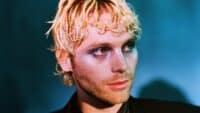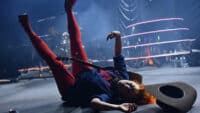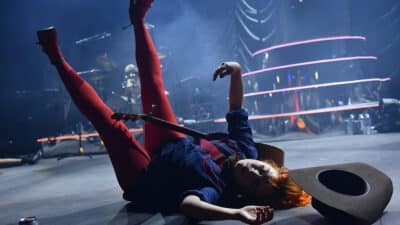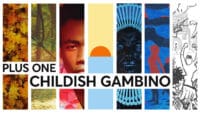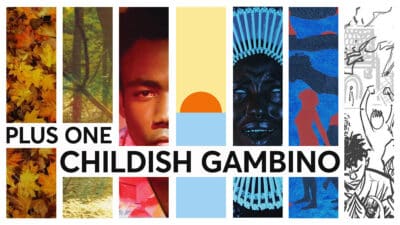Music

Interview
Meet Me In The Bathroom: behind the scene
Directors Dylan Southern and Will Lovelace talk the making of the year’s most unmissable music doc
Where does a scene start and end? Somewhere between the 2001 and 2011, New York witnessed the rebirth of rock and roll – a post-punk revival that exploded out of the underground and changed mainstream indie forever. This was The Strokes, The Yeah Yeah Yeahs, LCD Soundsystem and Interpol. It was The Rapture, The White Stripes and TV On The Radio. Dirty Converse, sweaty floors and LimeWire.
However hazy the beginning and end of the New York scene might have been, the period now stands as one of the most influential movements in music history. First chronicled in full in Lizzie Goodman’s seminal 2017 book, the filmmakers behind No Distance Left To Run and Shut Up And Play The Hits have now curated 10 years of archive footage into the definitive documentary of the era.
We caught up with Meet Me In The Bathroom directors Dylan Southern and Will Lovelace to find out how they did it.
Where did you even start with this? How much did the shape of the film change as you waded through all the archive material?
Dylan Southern: The Blur film was a typical rock documentary, and then Shut Up And Play The Hits was a concert movie. This was the first time we tackled something that was purely made from archive, and it definitely presented a whole new set of challenges.
Our starting point was Lizzie Goodman’s book, obviously, and we did do a whole period of writing before anything else, so we had an idea of the story we wanted to tell. But deciding to make it archive-only meant that we were sort of beholden to what existed, and what we could find. So it mostly involved a hell of a lot of detective work. And we had to be adaptable. It was a constant process of knowing what story we wanted to tell and refining it as we went along.
What appealed to you about the 00s New York rock scene? Has making this film changed your perspective at all?
Will Lovelace: I think one of the things that we loved about the book was that it seemed to document a time before everything changed. Before the world became what it is today. And that’s what we were really interested in. Looking at that period of time just as the internet started to change everything; when the way music was listened to changed, when all those technological revolutions were happening. I think you look back now and you think, “could that happen again?”. “Is that the last time a scene like this could happen in one city in one time?”. And I think it probably wouldn’t.
Southern: We were interested in the idea of the mythology around music scenes. That’s why we start the film with a look back at the iconic snapshots of New York musicians and scenes of the past. A big question we wanted to leave the audience with was also “will these bands have the same legacy as those that came before?”. “Has the world changed too much in the intervening years for them to become part of that canon?” We were really interested in the notion of a “scene” as well, and the fact that those guys on the ground in New York weren’t necessarily all hanging around with each other. It very much took the British music press to sort of corral them all together, because the musicians in the film are actually quite disparate. If you think about James [Murphy] and what he’s doing, fusing dance music with punk and then rock; and then look at The Strokes and Interpol… all very, very different bands that are somehow part of the same scene. So we were really interested in the diversity of music that was happening, and also in the external forces that fused everything together.
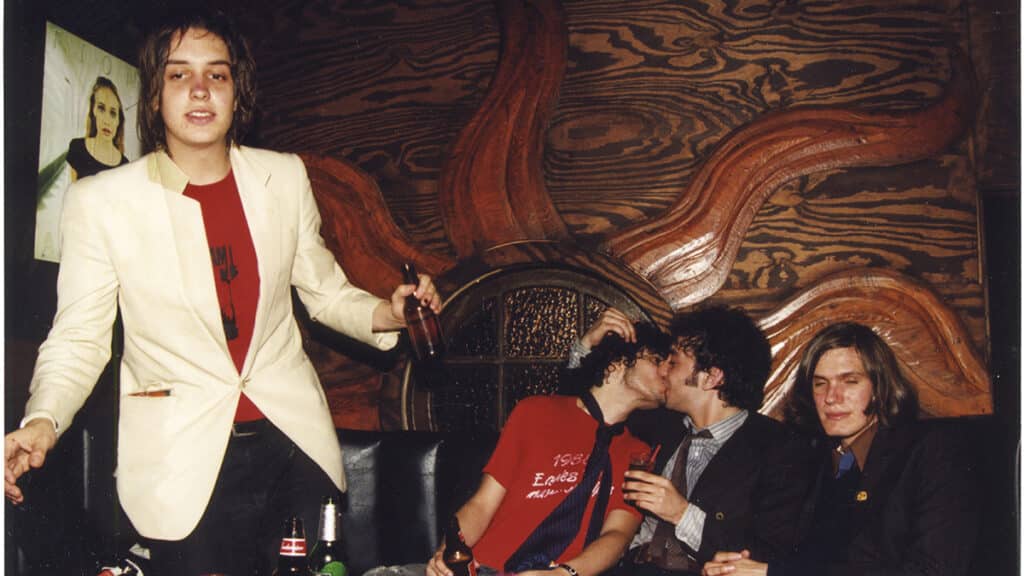
CREDIT: Piper Ferguson
The film does a great job of capturing the chaotic energy of the time too, which isn’t always easy for a documentary to pull off. How much of that was part of overall ambition?
Lovelace: I think it was all in the archive. The footage we discovered really allowed us to get across that feeling of what it was like to be there.
Southern: Yeah, and I think the absence of talking heads helped as well. All these guys still look great today, but it kind of breaks the spell when you see people who are like, our age, talking about how great it was 20 years ago. So the ethos of the film was just to drop people into the time and let it unfold in front of them. And I think you get the aesthetic of it in the archive too, with people shooting on mini DV tapes for the first time.
I remember hating the way that DV looked, because I was very romantic about Super 8 and 16mm film. Now, 20 years later, it’s that mini DV footage that makes me feel nostalgic, and it has that same quality. That scrapbook aesthetic just transports you right back there. Up until making this film it all felt like five minutes ago. And then suddenly we’re faced with the sort of existential crisis that this was all 20 years ago…
Lovelace: When you go to a gig today there’s 500 people filming on their phones. In almost all of the shows that we found, it was one person with a camera taking photographs. And I think that gives you a slightly different perspective.
Southern: And it also kind of gives you a privileged view. If someone makes an archive-only documentary about a band from today, they’re gonna have a different problem to us. They’re going to have so much footage to wade through. We really had to become detectives. We were doing things like looking at a photograph and noticing a MiniDisc recorder in the corner – then finding out which outlet it was shot for, tracking down the journalist, and charming them into digging out their old MiniDiscs that they might still have somewhere in a box.
There’s one shot in particular – Paul Banks wandering through the wreckage of 9/11 – that really stands out. That must have been quite a moment when you found that?
Lovelace: Yeah, definitely. Paul told us early on that him and his flatmate had gone out on the day of 9/11 and filmed some stuff. But when we saw it, we knew it had to be included. It kind of allowed us to tell that moment in the story. 9/11 was so connected to these characters, and it was really important to us that we could show that.
What else stood out when you were going through the archive?
Southern: Some of the really early Strokes footage was amazing. We found a lady called Nancy who had been on the scene and hung around with a lot of different bands as a photographer and videographer. And it turned out she had a lock-up in LA, and we found this suitcase in there that just had loads of undeveloped 35mm film rolls and loads of DV tapes. That footage of The Strokes, when their bond was strongest, when they’re messing around in the subway, no one’s ever seen that stuff before. So it was exciting to find things like that.

CREDIT: Josh Victor Rothstein
How long was the first cut of the film? I know there was early talk of this being a TV series instead a feature.
Southern: I think it was about four hours. There’s that cliche that you have to kill your darlings when you’re editing, but it’s so true. There was so much great stuff that didn’t make the cut, but we didn’t want it to outstay its welcome. We’re following four key bands or characters, as well as some of the satellite artists around them, and that’s a lot to include in 100 minutes. So it was a process of really just interrogating the best way to tell each story. Our feeling was that we can never be as granular as the book, but we can make a film that makes it feel like you were there. And then if people haven’t read the book, the book’s there for them to pick up and read the bigger story.
‘Maps’ is the only song we hear played in full. Where did that decision come from?
Lovelace: I think we always knew ‘Maps’ would be the kind of centerpiece, certainly to Karen’s story in our film. The band were very generous and they gave us the footage and rushes from that music video, which is an amazing video. The edits are amazing, but what was brilliant was us being able to show it in a slightly different way. Just holding that long shot of Karen, as she’s performing it in the video.
Southern: It’s such an iconic song and video. I think that song is the most sampled song from that period. Even Beyoncé has used it. But there’s also just such raw emotion in Karen’s performance, and it really feels like it captures who she was and where she was at that time. In some of the live performances you get Karen’s alter ego, but in that video, you get her vulnerability. It sort of comes at a point in both her life and the story we tell in the film where you need to concentrate on what she’s going through.

CREDIT: Rival Wijesooriya
Have you had any reaction from any of the people featured in the film?
Southern: Yeah we’ve had a great reaction. Not from everybody… [laughs] but everyone we know in that scene is really supportive. The Yeah Yeah Yeahs came to the premiere, and Adam and Kimya reformed the Moldy Peaches for the event too, which was amazing. The guys from Interpol have been great too. Everyone’s been really positive about it.
What about the reaction from audiences? It’s the kind of film that evokes so much nostalgia – you must have had a lot of memories shared with you?
Lovelace: For sure. And having sat in an edit suite for so long, with the five or six of us who actually made the film together, it’s such an amazing feeling when you finally get to show it to a cinema audience. It’s a communal experience.
Southern: At the end of the edit, you never want to see it again [laughs]! So you need that moment with an audience, because you’ve been so long in the weeds. The more interesting reaction has actually been from younger people who perhaps didn’t experience it firsthand. My friend’s son saw it and he couldn’t get his head around a world without smartphones! Also the whole DIY aspect of promoting a band – posting off CDs, making your own flyers and all that kind of stuff. It was a different time.
Meet Me In The Bathroom is released at UK and Irish cinemas from 10 March 2023.





